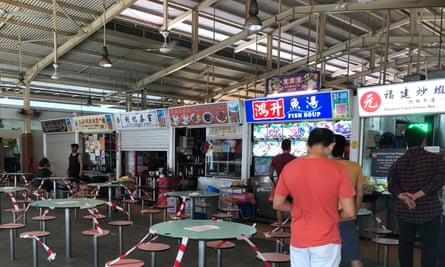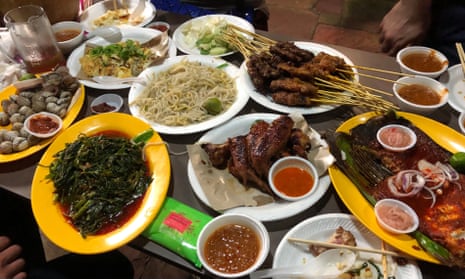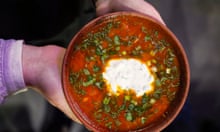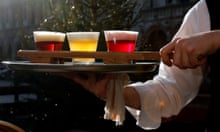One of Singapore’s most-loved institutions has been given a timely boost, with the country’s hawker culture being added to the Unesco list of Intangible Cultural Heritage of Humanity.
The award took place at a virtual ceremony on 16 December and it sees the culture join the likes of yoga in India and the tango in Argentina. Hawker culture refers to the community of vendors who cook and sell meals in the 114 hawker centres across the city-state. The verdict could not have come at a better time for the vendors, providing invaluable protection after a precarious year.
The food halls are considered the nation’s dining rooms, where people from all walks of life mingle and eat cheap, freshly cooked dishes from morning to night. Hawkers sell many things, from whole roasted ducks and steamed pork buns to pig’s trotters and fish-head curry. As Anthony Bourdain wrote during his 2017 visit: “The hawker centers are wonderlands of Chinese, Indian, and Malay specialties [sic]. It’s like shooting fish in a barrel making food porn in Singapore.”
Bourdain’s praise added to the increasing respect hawker food has gained internationally. Last year, of the 58 places to eat in Singapore that made it on to the Michelin Bib Gourmand list, 33 were hawker stalls. Several of the stalls even have Michelin stars, which makes Singapore home to some of the cheapest Michelin-starred food in the world. The first hawker to achieve this feat was Liao Fan Hawker Chan in the Chinatown Complex Market, in 2016. For three Singapore dollars (around £1.65), diners can get a plate of Chef Chan’s soy sauce chicken rice – if they are prepared to embrace the long queues.
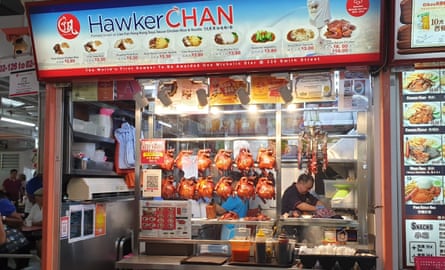
Each stall tends to have its speciality, usually perfected over years of hard work. In Ghim Moh Market, Kelly Ng, 50, sells laksa (noodles in a coconut-shrimp soup) using his grandfather’s recipe. He serves one size, in one style, at one price ($2.50/£1.40) – dishing it out in small blue-and-white ceramic bowls.
“The ceramic keeps the broth the perfect temperature, and the size of the bowl means it’s just enough but not too much,” he says.
Despite the accolades and local love for hawkers, though, the culture has faced challenges in recent years. Hawkers are ageing – the average vendor is 59 – and there are few young Singaporeans keen to adopt a profession that entails 14-hour shifts. The cost of raw ingredients is also rising, but the average dish price is kept low so that people of all incomes can afford it – meaning profit margins can be small.
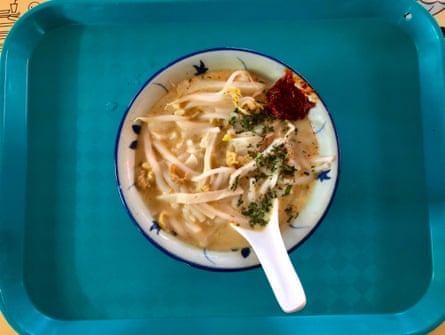
The coronavirus pandemic only made matters worse. In April, when Singapore went into circuit-breaker restrictions, all dining at hawker centres was halted. Though takeaways were permitted, some hawkers had to cease trading because they were losing money by staying open.
For those who continued trading, business was bad. Chong Yuen Har, 64, owns a stall in Hong Lim Food Centre, near the finance district. She has been working there since 1979, making bak kut teh (pork rib soup) from 5am until 8pm, seven days a week. Overnight, she saw her business drop by about 80%. Even now, with the virus largely under control in Singapore, her business is still making half of what it did pre-Covid.
“It’s been hard,” she said, “but I intend to keep doing this for as long as I can. I don’t want to worry about it; we are all facing the same situation.”
When the circuit breaker was announced in Singapore, social media groups popped up in recognition of the hawkers’ hard work. One Facebook group, Hawkers United, had 25,000 members within a few days of launching. Other people have used the hashtag #thankyouhawkers on Instagram, posting messages of appreciation for their long hours and tireless commitment.

Two Singaporean friends, Elroy Lim, 33, and Tai Zhang Kai, 30, saw some of the older hawkers struggling at the start of the pandemic and decided to help.
“Younger sellers could modernise quickly, getting business through delivery platforms and social media publicity,” says Lim, “but the older aunties and uncles [the affectionate name for senior Singaporeans] didn’t know what to do.” In April, the pair founded Hawker Heroes SG, a commission-free delivery service that supports the hardest-hit hawkers.
Unlike with some delivery platforms, every cent of the food cost goes back to the hawkers, so Lim and Tai do not make a profit: in fact, they operate at a loss.
“It’s worth it, though,” says Lim. “We’re able to help the hawkers who need it the most.”
Alongside the community-led initiatives, Singapore’s National Environment Agency has plans to safeguard hawker culture, including a new programme called the Hawker’s Succession Scheme in the first quarter of 2021. Veteran hawkers will be paired with aspiring vendors to pass on their skills, recipes and business knowledge – with the intention for them to take over the stall when they retire.
These plans, together with Unesco’s recognition, signal a brighter future for the trade – especially in the wake of a challenging year. As Lim says: “The hawkers sacrifice their time, their margins and their energy for us to be able to enjoy and afford their food. They’re the real superheroes: it’s time they finally got that recognition.”
Five hawker centres to visit when travel resumes
For those who’ve watched the film Crazy Rich Asians, the leading couple’s first night in Singapore showcases the colourfully chaotic Newton Food Centre – the hawker centre most tourists visit during a trip to Singapore. While Newton is great fun, the prices tend to be steeper and touts try to rope you into their stalls (uncommon across the rest of Singapore). For a more “traditional” hawker experience, try these places.
Old Airport Road Food Centre
This huge two-storey building is one of the country’s oldest and largest hawker centres, opened in 1973 on the site that was once Singapore’s first civilian airport. It’s hot and sticky and the constantly whirring fans do little for airflow, but it’s about as authentic as it comes. Last year, it was voted Singapore’s best hawker centre by local radio station 96.3 HAO FM, with twice as many votes as its nearest competitor. There’s so much food to choose from, the best bet is to just join the longest queue: you know it’ll lead you to something good.
51 Old Airport Rd, no website
Changi Village Hawker Centre
By leafy Changi Beach Park – not far from the international airport – this hawker centre is one of the furthest from the main city, but it’s well worth the journey. Split across two open-sided halls, it’s known for its many nasi lemak stalls (a Malay dish of fragrant coconut rice, usually served with cucumber, eggs, peanuts and deep-fried fish or chicken). You can cycle the 25km from Marina Bay, following the tree-lined “park connector” cycleway that runs through Singapore’s East Coast Park. City bikes can be rented through apps like Anywheel and SGBikes.
2 Changi Village Rd, on Facebook
East Coast Lagoon Food Village
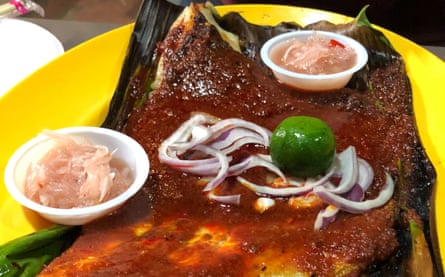
Standing in the aforementioned East Coast Park, this hawker centre is always busy at weekends thanks to its breezy beachfront location – a popular place for a walk after eating. It’s great for satay washed down with a Tiger beer. Wait times can be long, but the satay stalls use a buzzer system to notify you when your dish is ready. The sambal stingray (stingray grilled on a banana leaf, topped with spicy sambal sauce) is another great dish to try.
1220 ECP, no website, reopens February 2021
Chinatown Complex Food Centre

Entering this dimly lit place, on the edge of Chinatown in an old building that resembles a car park, can feel a little intimidating at first. The ground floor is home to a wet market and an array of knick-knack stands, but upstairs you’ll find more than 250 food stalls in a maze of corridors and connecting rooms. You can get pretty much any food you’re craving here (including Liao Fan’s Michelin-starred chicken rice) – and for something to wash it down, head to Smith Street Taps (stall #02-062) for a selection of more than 20 local and international craft beers on tap.
335 Smith Street, on Facebook
Ghim Moh Market
